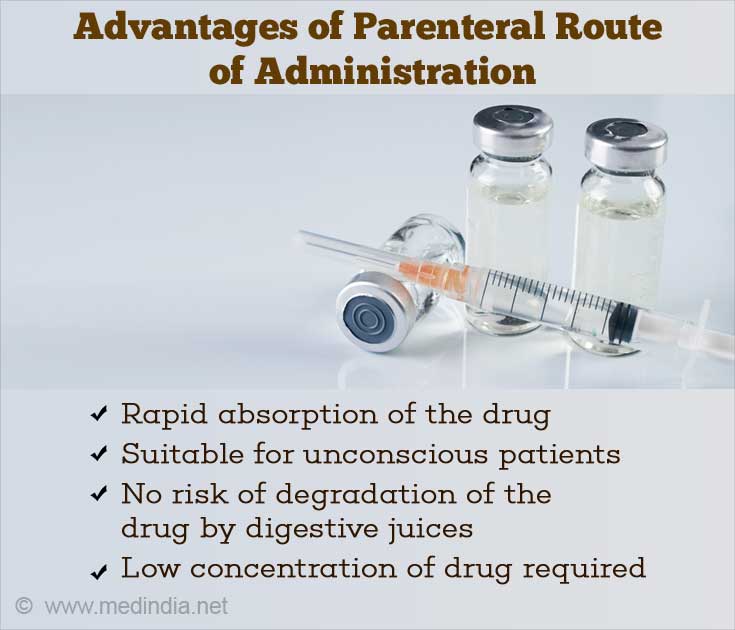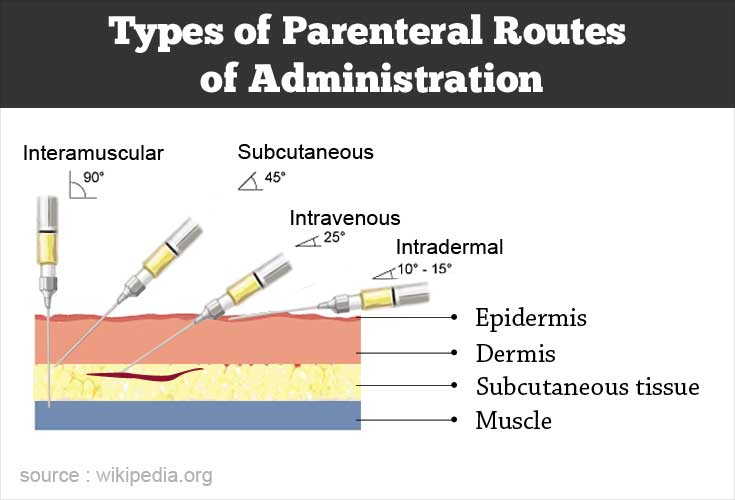- Route of administration - (http://www.paincommunitycentre.org/article/route-administration-0)
- US Food & Drug Administration - (https://www.fda.gov/drugs/developmentapprovalprocess/formssubmissionrequirements/electronicsubmissions/datastandardsmanualmonographs/ucm071667.htm)
- Alternative Routes of Drug Administration—Advantages and Disadvantages - (http://pediatrics.aappublications.org/content/100/1/143)
- Using Skin Patch Medicines Safely - (https://www.poison.org/articles/2012-aug/using-skin-patch-medicines-safely)
Introduction on Routes of Drug Administration
Routes of drug administration refer to the right path or the required route through which a drug has to be administered into the body to obtain maximum benefit.
A drug administered into the body undergoes several chemical and metabolic changes. These changes reduce the availability of the drug at its final site of action in the body. For example, some drugs may not be effective when administered orally, but may be effective when administered through injection.
Choosing the correct route of drug administration reduces or bypasses these changes, thereby helping to obtain the drug’s maximum therapeutic effect. In addition, some drugs are maximally absorbed when they are administered through a particular route as compared to another route. An intravenous route of administration of the drug results in 100% bioavailability.
According to the Oxford Concise Medical Dictionary, bioavailability is “the proportion of a drug that is delivered to its site of action in the body. This is usually the amount entering the circulation and may be low when the drugs are given by mouth”.
What are the Reasons for Selecting a Particular Route of Administration?
There are several reasons which determine the preferred route of administration of a particular drug. These include:
- Drug properties
- Physical - solid, liquid, and gas. For example, drugs in gas form are given by inhalation.
- Chemical - solubility, pH, and irritant properties.
- Site of desired action
- Localized and approachable: For example, a skin lesion can be treated with local creams so that maximal effect can be obtained and side effects on the other parts of the body can be avoided.
- Generalized and non-approachable: For example, oral or injection antibiotics will be required for infections affecting the internal organs of the body.
- Rate and extent of absorption from the drug administration site: Drugs used in emergencies are usually given intravenously for quick effect.
- Effect of digestive juices and first pass metabolism: For example, since nitroglycerine is digested to a large extent when taken orally, it is given by alternate routes.
- Rapidity of the desired response in case of emergency or in routine treatment. Cases of emergency usually require intravenous injections so that the medication can reach its site of action quickly.
- Requirement of accurate dose (of the dose in case of intravenous or inhalational routes can be adjusted accurately during the treatment depending on the patient’s response).
- Patient condition and compliance (pediatric or geriatric patients, or unconscious patients, or any disease conditions). For example, unconscious patients cannot take drugs orally. Compliance refers to whether the patient follows medical advice correctly or not.
What are the Routes of Drug Administration?
1. Gastrointestinal route:
a) Oral route - This is the most common and easiest route of administration where drugs are given by mouth. Dosage forms administered orally include tablets, capsules, syrups, effervescent powders, elixirs, and emulsions.
The oral route is considered as the first choice of route of drug administration as it is most convenient, cheap and usually a safe method of drug administration.
The orally administered medicines are mostly absorbed in the small intestine, and to some extent in the stomach. Some orally administered drugs are specially designed with an enteric coating to withstand the stomach’s digestive juices and to disintegrate in the small intestine.
First pass metabolism is a major problem that is encountered with orally administered drugs. The drugs absorbed from the small intestine first reach the liver through the portal circulation. The first pass effect or the first pass metabolism is the process of drug metabolism by which the drug concentration is reduced to some extent by the liver before it enters the bloodstream.
Hence, the oral dose is usually higher when compared with the dose administered through other routes because of the first pass effect by the liver. The bioavailability of the orally administered drug may increase when the liver suffers from a disease such as cirrhosis. Two or more drugs taken together can also alter a drug’s bioavailability, and therefore dosage adjustment may be needed.
Drugs undergo first pass metabolism to a variable extent. Commonly used drugs that undergo extensive first pass metabolism are cimetidine, lidocaine, propranolol, nitroglycerin, diazepam, midazolam, morphine, pethidine, imipramine, and buprenorphine. Some drugs like insulin are destroyed by the gastric secretions and therefore cannot be given orally.
Disadvantages of oral route:
- Drugs such as aspirin or ibuprofen (NSAIDs) may irritate the gastrointestinal tract by harming the gastric lining and aggravate existing stomach ulcers.
- Some drugs are poorly absorbed orally or undergo extensive first pass metabolism, which may reduce the effectiveness of the drug.
The oral route of drug administration is not preferred in:
- Unconscious patients
- Patients with restrictions to oral intake
- Patients who are vomiting
- Emergency situations where a rapid response is necessary
b) Sublingual route:
‘Sublingual’ in Latin term means ‘under the tongue’. Drugs administered through this route diffuse into the bloodstream through the tissues under the tongue. The mucous membrane under the tongue is supplied with a bed of rich capillaries. Therefore, the sublingual route has a faster absorption rate when compared with the oral route.
The sublingual route of drug administration has an advantage of bypassing the liver first pass effect. As a result, a lower dose of the drug is required when compared with the oral route. Excess drug can be spat out. The dosage forms used sublingually include the sublingual tablets, strips, drops, and sprays.
Drugs used sublingually include nitroglycerine and buprenorphine.
c) Buccal route:
The buccal route is the route of administration where the medicine is placed between the gums and the inner lining of the cheek. This route of administration has the same advantages as of sublingual route but the difference is the site of application.
Drugs used by this route include fentanyl buccal patches, nicotine tablets as smoking cessation aid and prochlorperazine in treating nausea and vomiting.
Disadvantages of sublingual and buccal route:
- May irritate the already existing open sores in the mouth.
- Extended-release formulations and large doses cannot be used.
- Inconvenience in placing on the exact site.
- The medicine effect will be reduced if accidentally swallowed.
- Nausea and vomiting may occur if the medicine is associated with unpleasant taste.
d) Rectal route:
The rectal route offers a faster, safer, and low cost route of administration when compared to several other alternative routes. The dosage forms of the rectal route of administration include suppositories and enemas.
The medicines given by rectal route are absorbed by the rectum’s blood vessels and enter the bloodstream. A drug administered rectally has a faster onset of action, high bioavailability, and produces less nausea when compared with the oral route.
The rectal route of administration undergoes less first pass effect and the drug concentration is also reduced only to a slighter extent from actual drug concentration.
The disadvantage of a rectal route is an erratic or irregular absorption, and the unacceptability of the route by some patients.
Advantages of rectal route:
- Best route of administration for children and elderly patients.
- Does not require hospital care setting and special sterile precautions.
- Useful for patients suffering from swallowing difficulties, bowel obstruction, and decreased propulsive movements in the gastrointestinal tract.
- Helps patients with terminal stage of illness. It can be administered to unconscious patients.
- Larger quantities of drugs can be used.
2. Parenteral route:
Parenteral route of drug administration means administering the drug through routes that bypass the digestive tract, through injections. The administration requires skilled medical personnel who administer the medication with the help of a syringe and needle or a catheter using aseptic precautions. The cost is higher than that of oral dosage forms and involves the pain of the prick of the needle, which may be scary for some.
The most commonly used parenteral routes of administration are subcutaneous, intravenous, intramuscular, and intradermal injections.
Advantages of Parenteral Route of Administration:
- Rapid absorption and faster onset of action of the drug
- The medication bypasses the liver first pass effect
- No risk of degradation of the drug by digestive juices
- Suitable for unconscious patients
- Low concentration of drug required

Types of Parenteral Routes of Administration:
a) Intradermal:
Intradermal route of drug administration involves injecting the medication into the dermis, a layer just below the epidermis of the skin. The amount of drug administered through this route is usually less than 0.5ml. This route has the longest absorption time among parenteral medications and is often used for diagnostic purposes for tests such as penicillin sensitivity, diphtheria test and Dick test for scarlet fever. The BCG vaccine for tuberculosis is also administered intradermally.
The body’s reaction to intradermal medicines is more easily visible as the site of administration is closer to the surface.
Injection sites: Inner surface of the forearm, upper back under the scapula / shoulder blade.
b) Sub-cutaneous:
A subcutaneous injection is administered under the skin into the fat layer just below the dermis of the skin. The absorption from the subcutaneous route is slow and sustained action as the tissue sites have fewer blood vessels. It has a slower action compared to intravenous but faster than an intradermal route.
Drugs used: Measles vaccine, insulin, morphine, and goserelin (a drug used to suppress sex hormones).
Injection sites: Outer area of the upper arm, abdomen, upper thigh, upper back, and upper area of the buttock.
c) Intramuscular:
The intramuscular route of drug administration involves injecting the medicine directly into the muscle. As muscles are rich in large blood vessels, the absorption rate is faster than subcutaneous and intradermal routes.
Oily, irritant and slow-releasing preparations can be given by intramuscular route. The disadvantage of this route is it may lead to nerve or vein damage.
Drugs used: Penicillin, haloperidol, diazepam, vitamin B12, methotrexate, platelet-rich plasma injections, vaccines such as hepatitis A, tetanus and hepatitis B vaccine.
Injection sites: Muscle area of the upper arm, buttocks or thigh.
d) Intravenous:
The route by which the medicines are directly introduced into the bloodstream through a vein is known as intravenous route of administration. The intravenous route is considered to be the fastest route of drug administration. The injections and the infusions are administered by this route have 100% bioavailability.
Drugs used: Electrolyte fluids, buffer solutions such as lactated Ringer’s solutions, parenteral nutrition medicines such as amino acids and vitamins, blood and blood-related infusions.
Injection sites: Peripheral lines, central lines, peripherally inserted central catheter, midline catheter, tunneled lines and implantable ports.
Disadvantages of intravenous route:
- Inflammation of blood vessels could occur
- Not suitable for oily and insoluble preparations
- Permeation of fluid may occur to the surrounding tissues
- Special apparatus such as infusion pumps, drip chamber, peripheral cannula and pressure bags are required

3.Topical route:
The word ‘topical’ in Greek means ‘of a place’. The topical route of administration refers to the application of the medicines to body surfaces such as skin and mucous membranes and includes transdermal patches, instillation applied to the eye, drops placed into the ear or medications applied to the surface of the tooth. These are painless in contrast to the parenteral route. A few drugs like desmopressin are administered nasally.
a) Transdermal patches:
A transdermal patch is a medicated adhesive patch which is placed over the skin to deliver specific or controlled dose into the bloodstream for a period of time. The drug enters the blood stream by a process of diffusion at a controlled rate. It is convenient to use. The disadvantages of this route are that it can be used only for the drugs with small molecules which can penetrate the skin.
Drug patches used: Nicotine patches, contraceptive patches, opioid patches, nitroglycerin patches, clonidine patches and estrogen patches.
Precautions while using transdermal patches:
- Apply to the clean, dry, or unbroken skin
- Make sure the adhesive patch sticks firmly
- Wash your hands after applying a patch
- Use only one patch at a time
- Patches are to be removed while undergoing x-ray or MRI scan
- If any skin irritation develops, the application site should be changed. Rotation of application sites is encouraged
- The removed patches should be disposed of safely by folding the sticky sides together to avoid contact with children
- If the patch falls off completely do not reapply but use the fresh one as per the dosing schedule
Application sites: Upper chest, upper outer arm, hip, lower abdomen
b) Instillations: Instillations include liquids or semisolid preparations introduced into the conjunctival sac (eye), ear, nose and open wounds.
c) Irrigation or Douching: This is used for washing the urinary bladder, vagina, uterus, and urethra; it is mainly used for antiseptic purposes.
d) Epidermic and enepidermic routes: The enepidermic routes involve the application of creams, ointments, lotions, and poultices that are applied to the surface of the skin.
The epidermic routes include the oily preparations that are rubbed onto the skin such as rubefacients to provide counter irritation. The rubefacient dilates the capillaries under the skin and increases the blood circulation used in treating the pain in various musculoskeletal disorders.
e) Throat paints: The medicines are applied to the throat to treat the throat infections with the help of a thin brush. Glycerin is the commonly used base to stick to the mucous membrane for a long period of time.
Examples are Iodine throat paints, Tannic acid throat paints
4. Inhalation route: The inhalational route of administration is an easy method of administration where the medicines directly pass into lungs. This route has quick action with minimal side effects and requires a lesser dose.

Drugs used: Volatile drugs and gases such as salbutamol aerosols and nebulization or steam inhalations of tincture benzoin.
Disadvantages of Inhalation route:
- The airway must be accessible
- Special apparatus and supervision or assistance is required
- Irritation of the airways may occur
Other Uncommon Routes of Drug Administration
Apart from the routes mentioned above, there are other routes of drug administration which are not commonly used but require skill, and should be administered by a medically qualified person in an aseptic environment.
| Route of administration | Description |
| Epidural | Administration between the dura mater (outer membrane of the brain) and the skull |
| Extra-amniotic | Administration into the space between the fetal membranes and endometrium inside the uterus |
| Intra-Arterial | Administration into the arteries |
| Intra-Articular | Administration into a joint |
| Intrabiliary | Administration into the gallbladder, bile ducts or bile |
| Intrabursal | Administration into a bursa (fluid filled sac which provides cushion between the bones and tendons |
| Intracardiac | Administration into the heart |
| Intracerebral | Administration into the brain |
| Intracoronary | Administration into the coronary arteries |
| Intracorpus cavernosum | Administration into the spaces of corpus cavernosum of the penis in males |
| Intradiscal | Administration into a disc in the spinal cord |
| Intraductal | Administration into the duct of a gland |
| Intraperitoneal | Administration into the peritoneal cavity |
| Intraprostatic | Administration into the prostate gland |
| Intrapulmonary | Administration within the lungs or the pulmonary bronchi |
| Intrasinal | Administration into the periorbital or the nasal sinuses |
| Intraspinal | Administration into the vertebral column |
| Intrasynovial | Administration into the synovial cavity of the joint |
| Intratendinous | Administration into a tendon |
| Intratesticular | Administration into the testicles |
| Intrathecal | Administration into cerebrospinal fluid (CSF) |
| Intratubular | Administration within the organ tubules |
| Intratumor | Administration into a tumor |
| Intravascular | Administration within the blood vessels |
| Intraventricular | Administration into the ventricle of the brain |
| Intravesical | Administration within the bladder |
| Intravitreal | Administration into the vitreous humor of the eye |
| Iontophoresis | Administration with the help of electric current where the ions of the soluble salts migrate into the tissues |
| Laryngeal | Administration directly on the larynx |
| Perineural | Administration surrounding a nerve or a bunch of nerves |
| Retrobulbar | Administration behind the eyeball |
| Transplacental | Administration either through or across the placenta |
| Transtracheal | Administration done through the tracheal wall |
| Transtympanic | Administration into the middle ear |
| Intraovarian | Administration into the ovary in females |
| Intrapericardial | Administration into the pericardium (a sac covering the heart) |
| Intraosseous | Administration into the bone |








